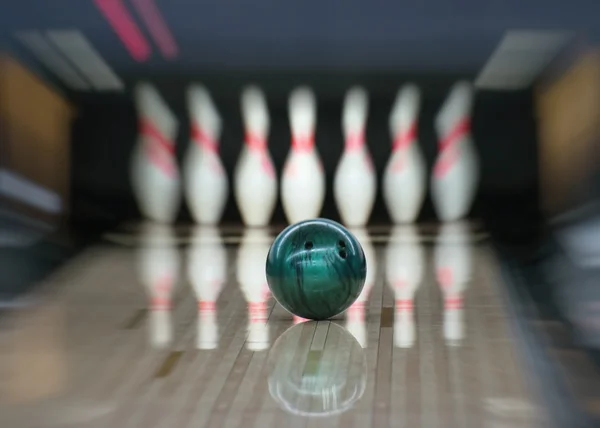Bowling is a timeless pastime enjoyed by millions worldwide.
Beyond its entertainment value, however, bowling offers numerous physical and mental health benefits.
Whether you’re a seasoned pro or a beginner, this sport can help improve your hand-eye coordination, burn calories, reduce stress, and boost confidence.
So, if you’re looking for a fun and engaging way to stay active and improve your overall well-being, it’s time to lace up those bowling shoes and hit the lanes.
Physical Benefits of Bowling
Improves Hand-Eye Coordination
Bowling involves aiming and releasing the ball toward a target while also keeping your balance and positioning your body in the right way.
To do this successfully, you need to have good hand-eye coordination, which means your eyes and hands are working together effectively.
With practice, bowling can help improve your overall motor skills by enhancing your ability to judge distance and aim accurately, as well as improving your reaction time and coordination between your hands and eyes.
This can translate to improvements in other areas of your life, such as driving, typing, and even playing musical instruments.

Burns Calories
Bowling can be an effective form of physical activity that burns calories. The amount of calories burned depends on various factors such as the person’s weight, the intensity of the activity, and the duration of the bowling session.
Generally speaking, a person can burn up to 300 calories in an hour of bowling, which is equivalent to a moderate-intensity workout.
This calorie-burning effect can be attributed to the constant movement involved in the sport, such as walking back and forth from the lane, picking up and throwing the ball, and the muscles used in the upper body, core, and legs.
Regular participation in bowling as a physical activity can contribute to weight loss and overall health improvement, especially when combined with a balanced diet and other forms of exercise.
Strengthens Muscles
Bowling is a physical activity that requires the use of several muscle groups in the body.
The repetitive movements involved in bowling can help strengthen and tone muscles in the arms, shoulders, legs, and back.
Specifically, the act of holding and releasing the ball can help to strengthen the forearm muscles, while the repetitive swinging motion can work the biceps and triceps.
Additionally, the movements required to walk back and forth to the lane, and to maintain balance during the throw, can help to engage the leg and core muscles.
With regular participation in bowling, these muscle groups can become stronger and more toned, contributing to overall improved physical fitness and better health.
Improves Flexibility
The movements involved in bowling require a degree of flexibility, particularly in the legs, hips, and shoulders.
These movements, such as the swing, release, and follow-through, can help to stretch and improve flexibility in these areas.
Improved flexibility can lead to a better range of motion, less muscle tension, and improved posture, reducing the risk of injury during physical activity and improving the overall quality of life.

Mental Benefits of Bowling
Reduces Stress
Physical activity, including bowling, can be an effective way to reduce stress levels. Exercise stimulates the release of endorphins, which are natural chemicals in the body that can boost mood and reduce feelings of pain and stress.
In addition, engaging in physical activity can promote relaxation and improve overall mental health.
Bowling, in particular, can be a low-impact and enjoyable form of exercise that can help to alleviate stress and promote relaxation.
Whether you bowl alone or with friends, the act of focusing on the game and the movements involved can help to take your mind off stressors and provide a much-needed mental break.
Incorporating regular physical activity, such as bowling, into your routine can have numerous benefits for your overall health and well-being.
Boosts Confidence
Bowling can also have positive effects on your mental health, particularly in terms of boosting confidence and self-esteem.
As you practice and improve your skills with the tips of bowling for begginers, you may start to feel more confident in yourself and your abilities.
Seeing progress and achieving goals can be highly rewarding and help to build a sense of accomplishment.
In addition, bowling with others can provide a social outlet and opportunities for positive social interactions, which can further boost self-esteem and confidence.
Provides Social Interaction
Bowling provides opportunities for social interaction, making it a great way to meet new people and spend time with friends and family.
The social aspect of bowling can help combat feelings of loneliness and depression, which can be particularly beneficial for individuals who may struggle with social isolation.
In addition, bowling with others can provide a sense of community and belonging, which can contribute to improved mental health and overall well-being.
Improves Focus
Bowling requires a significant level of focus and concentration, particularly when it comes to aiming and making precise shots.
As a result, regular participation in bowling can help improve mental clarity, concentration, and overall cognitive function.
The act of focusing on the game and the physical movements involved can also help to improve hand-eye coordination, reaction time, and spatial awareness.
These skills can have broader applications in other areas of life, such as work or school, and can contribute to improved overall cognitive function and productivity.

Advantages and Disadvantages of Bowling
Advantages of Bowling
Bowling is a form of exercise that can help improve overall health. Some of the benefits of exercise, including bowling, include lowering the risk of stroke and heart attacks, reducing the risk of diabetes, improving bone density, increasing circulation, lowering cholesterol levels, and helping the body utilize oxygen better.
Bowling can also aid in weight loss, as it increases metabolism. Depending on the effort exerted and the weight of the bowler, he or she can burn anywhere from 150 to 300 calories an hour.
Bowling is a social activity that can be enjoyed with friends and family. It can also help develop social skills and improve mental health by providing a sense of accomplishment and social interaction.
Bowling is relatively low-impact on the joints compared to other sports, making it an ideal activity for people of all ages and fitness levels.
Disadvantages of Bowling
One of the biggest disadvantages of bowling is that it is an anaerobic exercise. This means that it does not provide cardiovascular benefits in the same way that aerobic exercise does.
Although bowling can help with flexibility, it does not provide the same level of stretching and muscle toning that other activities such as yoga or strength training might offer.
There is no defense in bowling, meaning you cannot stop someone from bowling or slow someone down if they are having a particularly good game. This can make it frustrating for some players.
Finally, there is a risk of injury in bowling, particularly if proper technique is not used or if the bowler does not warm up properly beforehand. Common injuries can include sprains, strains, and even fractures.
Frequently Asked Questions
Can bowling help with anxiety?
Yes, bowling can help with anxiety as it provides both physical and mental benefits.
Physical exercise has been shown to reduce anxiety symptoms by releasing endorphins, which are chemicals that promote feelings of well-being and happiness.
Bowling also provides a mental break from everyday stressors, allowing individuals to focus their attention on the game and forget about their worries for a while.
Additionally, the social aspect of bowling, particularly when played in groups, can help reduce feelings of loneliness or isolation which may contribute to anxiety.
Does bowling count as physical activity?
Yes, bowling counts as physical activity. Bowling involves walking, swinging, and releasing a heavy ball which requires both muscular strength and endurance.
This physical activity can help burn calories, improve cardiovascular function, increase muscle tone, and strengthen bones.
The amount of physical activity depends on the effort exerted and the weight of the bowler, but it can range from light to moderate-intensity exercise.
Does bowling help with weight loss?
Yes, bowling can aid in weight loss. Bowling involves continuous movement and requires a certain degree of physical exertion which results in the burning of calories.
The amount of calories burned during a game depends on various factors such as the effort exerted, the weight of the bowler, and the number of games played.
On average, a person can burn approximately 150-300 calories an hour while bowling.
In addition to burning calories, bowling can also help increase metabolism which contributes to weight loss.

Is bowling a good exercise for seniors?
Yes, bowling is an excellent exercise for seniors. Bowling can provide physical and mental benefits that are particularly important for seniors.
Seniors can benefit from the low-impact nature of bowling as it puts less stress on joints and muscles than other forms of exercise.
It can also improve balance, coordination, and flexibility, which can help prevent falls and injuries in older adults.
Additionally, bowling has been shown to help with weight loss, increase metabolism, and promote a healthy heart.
The social aspect of bowling can also provide mental health benefits, such as reducing feelings of loneliness and isolation, which can be common among seniors.
What muscles are worked during a game of bowling?
Bowling involves the use of multiple muscle groups throughout the body.
The main muscles worked during a game of bowling are the calf, hamstring, and quadriceps muscle groups, as these muscles are used when walking and lunging forward to release the ball.
Additionally, the arm, shoulder, chest, and back muscles are used during the swinging motion to release the ball with precision and accuracy.
Overall, a game of bowling can help tone and strengthen various muscle groups in the body.
Conclusion
Bowling offers numerous benefits for both physical and mental health.
It can help improve hand-eye coordination, flexibility, muscle strength, and focus, while also reducing stress levels and providing opportunities for social interaction.
Whether you’re a seasoned bowler or just starting out, incorporating bowling into your regular routine can have a positive impact on your overall health and well-being. To make your bowling game more fun, learn about how to bowl a strike.
So next time you’re looking for a fun and engaging activity that offers both physical and mental benefits, consider hitting the lanes and bowling a few frames!

